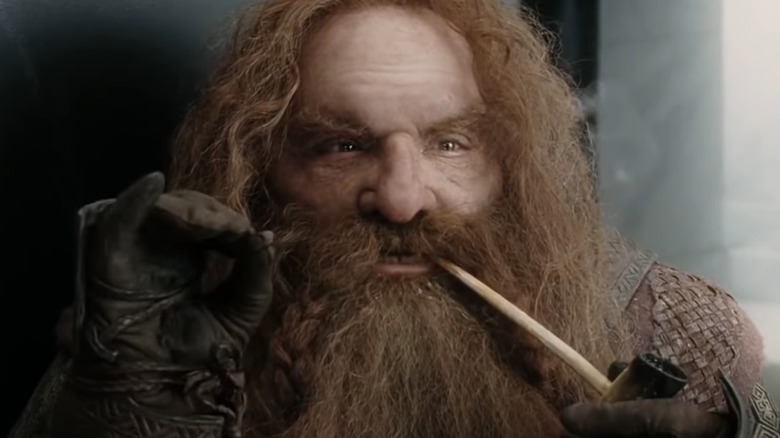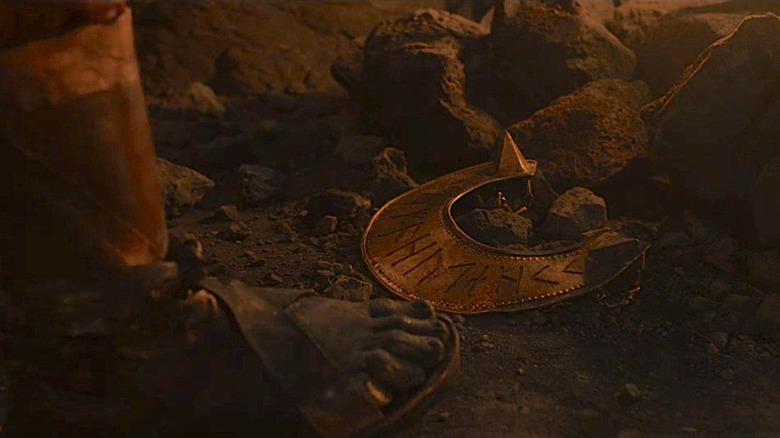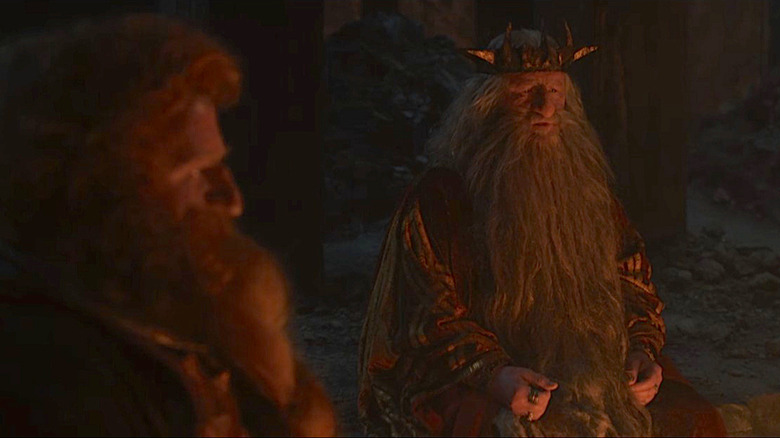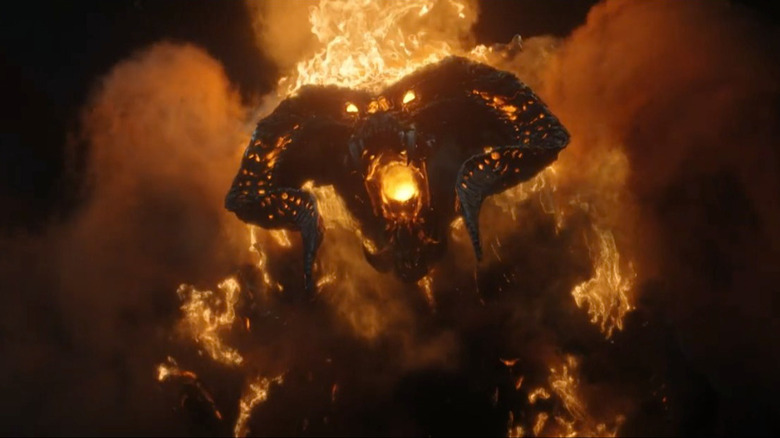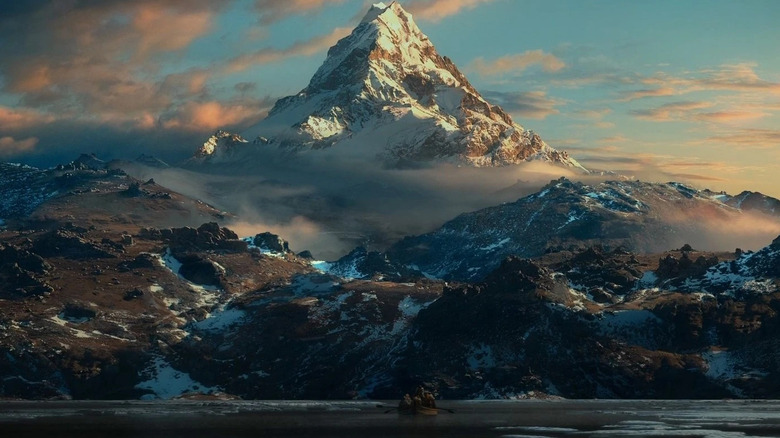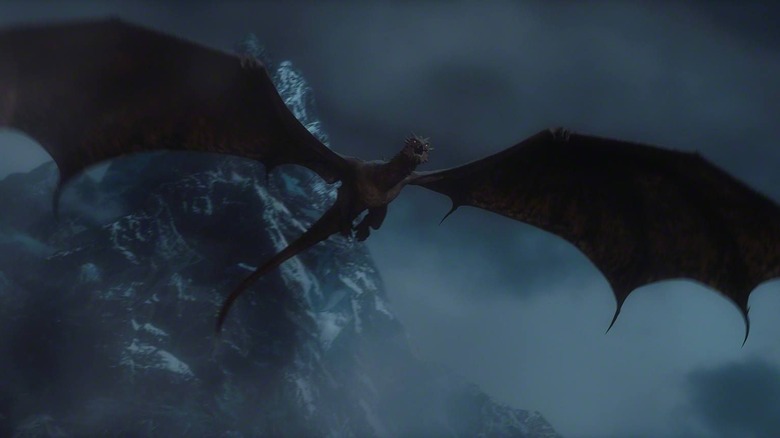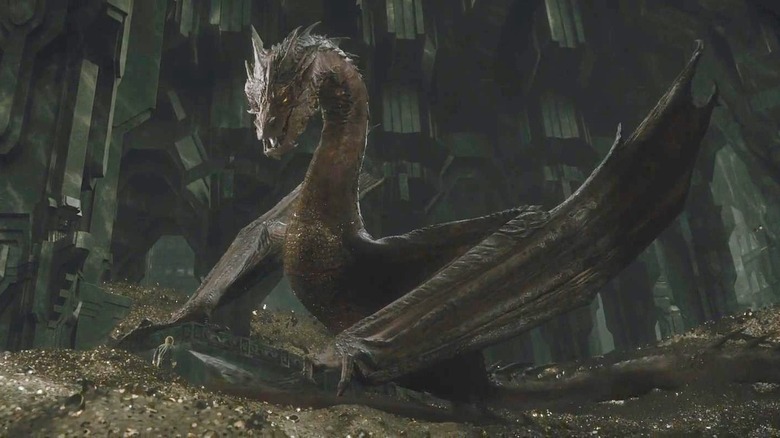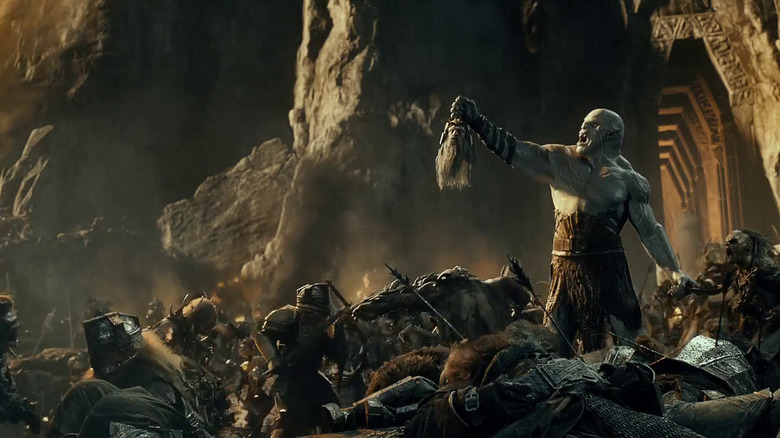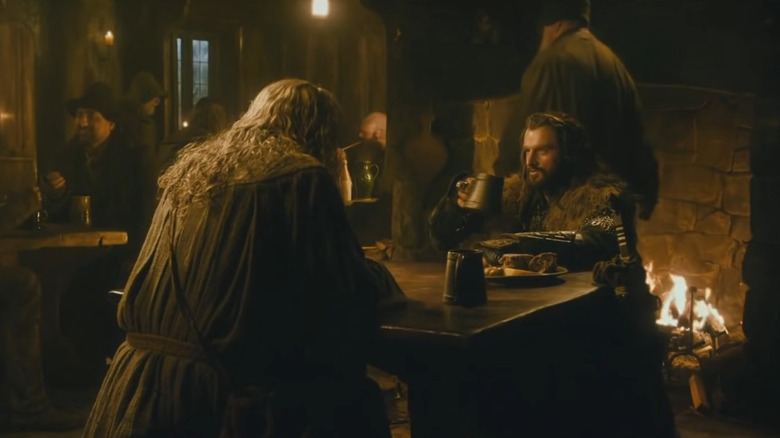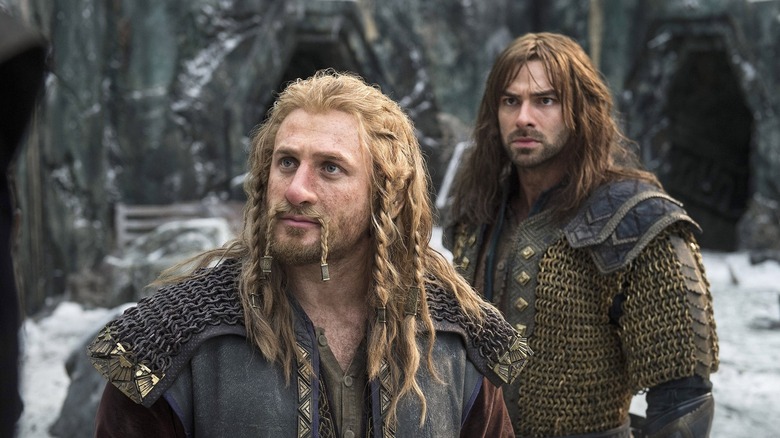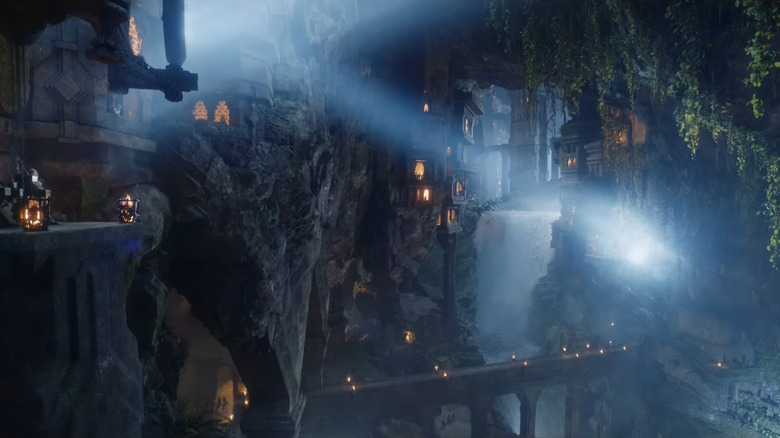The Hobbit: Thorin Oakenshield's Ancestry Explained
The race of the Dwarves plays a quiet yet important role throughout J.R.R. Tolkien's world of Middle-earth. Gimli is the poster child of the hardy Dwarven race in both the written and filmed versions of "The Lord of the Rings." We also get a sizeable dose of Dwarvish culture (and its fascinating royal line of Durins) via Khazad-dûm in Amazon Prime's Middle-earth adventures. And yet, "The Hobbit" is the Tolkien tale where the Dwarves truly shine.
That story is centered on the "Stunted People" themselves as a gaggle of thirteen bumbling Dwarves who, along with a Wizard and a Hobbit, embark on a quest to retake their home. Throughout this journey, they're led by their fearless exiled king Thorin. When Thorin enters the story for the first time in "The Hobbit" book, the author describes him as an enormously important, haughty Dwarf who represents a venerable line of kings forced into exile by the infamous Smaug the Golden.
While Thorin's attitude softens over the course of the story, his connection to royalty remains as relevant as ever, begging the question: who is Thorin related to, exactly? For newbies to the tale, there are a lot of similar names, like Thrór and Thráin, tossed around. And then there are the other well-established Middle-earth Dwarves we already mentioned, like Gimli and the Durins (all of whom are also distantly related to Thorin, too). To truly understand Thorin's complicated and convoluted family tree, though, one needs to head back to the beginning of Middle-earth history itself.
Dwarven origins and Durin I
The story of the genesis of the Dwarves is fascinating. For the purposes of tracing Thorin's family tree, though, there are a couple of important takeaways at this earliest point in Dwarven history. In their beginning, there are seven Fathers of the Dwarves who are created and placed at different points across Middle-earth. The oldest and most famous of these Fathers is Durin I, who wakes up and wanders for a long time through the freshly created world of Middle-earth.
In the book "The Fellowship of the Ring," Gimli recites a song about Durin: "The world was young, the mountains green, No stain yet on the Moon was seen, No words were laid on stream or stone When Durin woke and walked alone." Eventually, the most famous Dwarven father arrives at a point in the Misty Mountains where he settles down. Over the millennia that follow, his new home turns into a subterranean mansion called Khazad-dûm. Yes, that Khazad-dûm.
This first Durin has a very long lifespan — in fact, he's literally nicknamed "Durin the Deathless," although the nickname has more meaning than just a long-lived individual (more on that in a minute). He's around for a lot of the early history of his people, who are called either Durin's Folk or the Longbeards. Despite his longevity, though, Durin I ultimately proves to be mortal, and when he dies, his kingdom continues to thrive under different Dwarven rulers.
A line of (kind of) reincarnated Durins
The Dwarves of Khazad-dûm have many kings over the course of their history. Some of these are recorded, and some aren't. But there are seven distinct monarchs who receive deliberate callouts in Tolkien's writings — and they're all named Durin. "The Return of the King" book breaks down this mirrored monicker phenomenon thusly: "Yet in the end [Durin] died before the Elder Days had passed, and his tomb was in Khazad-dûm; but his line never failed, and five times an heir was born in his House so like to his Forefather that he received the name of Durin." (Yes, five plus one is six, but we'll explain the seventh Durin in a bit.)
The book goes on to explain how this factors into Durin's "deathless" nickname: "He was indeed held by the Dwarves to be the Deathless that returned; for they have many strange tales and beliefs concerning themselves and their fate in the world."
So, whether it's a literal reincarnation or just some similar-looking family traits, several Dwarven kings receive the "Durin" title over the millennia. Interestingly, there's nothing in Tolkien's writings about the Durins being consecutive father-son pairings or two Durins living at the same time (which contradicts "The Rings of Power" narrative). Nevertheless, over the late First, entire Second, and early Third ages, we get Durin II, Durin III, Durin IV, Durin V, and Durin VI. All this time, they rule the still-thriving kingdom of Khazad-dûm, that is until their people delve a little too greedily.
Durin meets his bane
Yes, we've reached the part of the story where a big, fiery Balrog shows up and routes the greedy Dwarves out of their ancient home. Once again, it's worth pointing out that in the source material and unlike in "The Rings of Power," this event doesn't take place when Durin III or even Durin IV is in charge. The unmitigated disaster occurs during the rule of the sixth Durin to date.
"The Return of the King" sets the stage for the catastrophe, saying, "It came to pass that in the middle of the Third Age Durin was again [Khazad-dum's] king, being the sixth of that name." It goes on to talk about how evil is stirring everywhere, and the Dwarves just keep on digging for mithril, which has fueled their wealth for generations by this point in time.
In this pursuit of mithril, the Dwarves dig too far and bump into a Balrog. Oops. The fiery demon does what you would expect any grumpy individual to do when they're woken up on the wrong side of the bed — it attacks its unexpected guests, kills a lot of them, and burns their home to the ground... or under the ground, in this case. In the process of this blatant overreaction, it kills Durin VI, earning the nickname Durin's Bane. Merriam-Webster primarily defines "bane" as "a source of harm or ruin: CURSE." Its second definition includes death, woe, destruction, killer, and slayer. Yep. All of these apply here.
The last king of Khazad-dûm and a lonely precipice
After the Balrog wakes up and begins trashing Khazad-dum, "The Return of the King" says that "Durin was slain by it, and the year after Náin I, his son; and then the glory of Moria passed, and its people were destroyed or fled far away." This is obviously a tragedy of epic proportions, but it also plays a key role in the story of Thorin's family tree. After a long line of Khazad-dûm-based kings, including six of the eventual seven reincarnated Durins, the Longbeards are forced to leave their home. The book goes on to say, "Most of these that escaped made their way into the North, and Thráin I, Náin's son, came to Erebor, the Lonely Mountain, near the easter eaves of Mirkwood, and there he began new works, and became King under the Mountain."
This migration, in effect, hits the reset button for Durin's Folk. It seems like it's an easy hop, skip, and a jump from here to Smaug attacking the mountain kingdom, too. But it turns out that the dispossessed Dwarves aren't quite as settled in their homeland as one might expect. In fact, their restless kings — Thorin's immediate ancestors at this point — continue to look for greener pastures. And they do so under the name of the first recorded Thorin in Middle-earth history.
The Longbeards go north ...and then south again
After establishing a new home base at the Lonely Mountain, the Longbeards decide that their already prosperous new kingdom isn't good enough, and they head even further north under their king, Thorin I (who, to make clear, is one of Thorin Oakenshield's ancestors, not the Dwarf himself). This time, they land in the Grey Mountains, where other Longbeard Dwarves had relocated after the Balrog debacle in Moria. Once again, things seem pretty good for a while, and they stick around for multiple centuries in their prosperous new home.
Then things go badly again because, well, these guys just can't catch a break. This time it's because of a new threat: dragons. The Dwarves duke it out with these new oversized pests until their king, Dáin I, and his son Frór, are killed. This scatters the Longbeards once again, with many of them heading back south to the Lonely Mountain, where they're ruled by Dáin's son, Thrór. This is where it all starts to come together. Why? Because Thrór is Thorin's grandfather.
So, to recap, Durin I is the eldest Father of the Dwarves. He settles Khazad-dûm, rules for a long time, and dies. His family continues to rule, with five of his heirs specifically being recognized as "other Durins" in his likeness. Durin VI stirs up a Balrog, and his people scatter northward. They settle the Lonely Mountain, head north for a bit, and return due to dragons... one of which follows them.
Thorin's family in exile
When the Dwarves return to the Lonely Mountain, the dragons they faced in the north generally leave them alone. However, in Thorin's own words in "The Hobbit," "There was a most specially greedy, strong and wicked worm called Smaug. One day he flew up into the air and came south." The Golden Dragon arrives at the Lonely Mountain kingdom and stomp-smashes its inhabitants to bits, sending the surviving Dwarves into exile yet again. Their king, Thrór, escapes, as does his son Thráin II and his grandson Thorin II (not Oakenshield yet), and they lead their people into a long period of wandering.
During the years that follow, the thrice-dispossessed Dwarves struggle to find their way. Old king Thrór eventually goes back to Khazad-dûm on his own to see the ancient mansions of his forefathers (likely driven by a lust for gold due to a magic ring he possesses — more on that in a moment). While there, he's killed by Orcs, sparking the famous War of the Dwarves and Orcs. This is the conflict that ends with a huge battle called the Battle of Azanulbizar. This takes place in front of the gates of Moria (an event portrayed in a flashback in "The Hobbit" trilogy), where the Orc-chieftain Azog is killed (unlike in the movie version where he survives), and Thorin earns his nickname of "Oakenshield" through his resourceful use of an oak branch in the fighting.
Thorin's brother is a burned Dwarf
In the Battle of Azanulbizar, the Dwarves win the fight, and Thorin earns a nifty nickname, but those are a small measure of compensation compared to the number of Dwarves that are killed in the fray. Nearly half of all of the Dwarves are dead by the time the fighting stops. The fallen are so numerous that the survivors opt to burn them on pyres rather than bury them. This is an extremely unique event that the appendices of "The Return of the King" book elaborates upon, saying, "Such dealings with their dead seemed grievous to the Dwarves, for it was against their use."
The note goes on to point out that the Dwarves typically don't just bury their dead. They do so in stone, never dirt. Burying that many corpses that way would take years, so they compromise with fire. The text adds, "But those who fell in Azanulbizar were honoured in memory, and to this day a Dwarf will say proudly of one of his sires: 'he was a burned Dwarf', and that is enough."
What does all of this have to do with Thorin's family tree? Unfortunately, a lot. The future King under the Mountain has two siblings. One of these is a brother, Frerin, who dies in this battle and becomes a "burned Dwarf."
Thorin becomes an heir in exile
After his grandfather is killed by Orcs, Thorin's dad, Thráin II, becomes the king of the scattered remnants of Durin's Folk. Before breaking down Thorin's father's story, we need to point out that both Thráin and his father possessed one of the Dwarven Rings of Power. While less utterly destructive than the Nine Rings for Mortal Men, these are still evil trinkets that corrupt the heart and make the Dwarves who wear them ravenous for riches.
Thráin initially leads his people way to the west, where they settle in the Blue Mountains (near the Shire and the old Elvish kingdom of Lindon). But Thráin festers in his pitiful exile. Eventually, lusting for gold in his mind — get this — he assembles a group of Dwarves and sets out on a quest to retake the Lonely Mountain from Smaug. Sound familiar?
"The Return of the King" appendix explains the fallout from this event. After setting out, Thráin and his companions are immediately pursued by Sauron's emissaries, including Orcs, Wolves, and evil birds. They get as far as Mirkwood, and then we get the line, "In the morning [Thráin] was gone from the camp, and his companions called him in vain." The Dwarf-king is captured by Sauron's servants and brought to his fortress in Mirkwood, where the Dark Lord lives at the time in his guise as the Necromancer. There, Thráin loses his ring before he's tortured and killed, making Thorin the new king of the Longbeards.
Thorin's closets kin are special people
We've finally reached the point where Thorin himself is the king. After a long line of monarchs (including six Durins), multiple exiles, many conflicts, and several new homes, the Dwarf-king's ancestral story has wound its way down to the man himself — er, the Dwarf himself. Before we wrap things up, though, it's worth going over a quick rundown of some of Thorin's most important and impressive relatives and descendants, too.
As for his personal family, we've already heard about his father, Thráin, and his burned-Dwarf brother, Frerin. Thorin's mother is never mentioned (even though she obviously existed at some point along the way). In fact, no Dwarf-women are mentioned in Tolkien's histories, with one exception. This happens in "The Return of the King" appendices where it says, "Dís was the daughter of Thráin II. She is the only dwarf-woman named in these histories."
Even then, Dís's role is merely that of the mother of her two sons, Fíli and Kíli. This inseparable pair forms the youngest members of Thorin's company when he sets out for the Lonely Mountain. They're also tragically killed in the Battle of Five Armies at the end of that quest. Thorin doesn't marry, and with the deaths of Fíli and Kíli, Thorin's branch of the royal line fizzles. So, that's the end of the story, right? Wrong.
Go west, Dwarf-king
Remember earlier when the Dwarves went to the Grey Mountains in the north, and then some dragons forced them to head back south again? Yeah, when that happens, some of the Dwarves opt to head further east. They mostly disappear from the history books until they suddenly return right before the Battle of Five Armies at the end of "The Hobbit". They're led by Dáin II Ironfoot, who hails from another branch of the royal line. So, when Thorin, Fíli, and Kíli die in that battle, Dáin is already on hand to become the next king of the Lonely Mountain. This keeps the dynasty in the family despite the tragic situation.
Dáin continues to rule for several decades until the War of the Ring breaks out. Then, as the events of "The Lord of the Rings" play out far to the south, Dáin and his Dwarves play a critical role in defending the northeastern portion of Middle-earth from the armies of Sauron. The old Dwarf-king even dies defending the Lonely Mountain, an event that causes Gandalf to state (once again in "The Return of the King"), "Yet things might have gone far otherwise and far worse." The Wizard goes on to point out that dragon fire and destruction would have devastated the northern regions were it not for his chance meeting with Thorin which sparked the quest to retake the Lonely Mountain and vanquish Smaug once and for all.
A happily ever after with Durin VII
The last important detail of Thorin's family tree has to do with the seventh and final Durin — also called Durin the Last. The book "The Peoples of Middle-earth" talks about this final chapter in the Longbeards' story in a few different places, at one point stating, "It was prophesied (by the Dwarves), when Dáin Ironfoot took the kingship in the Third Age 2941 (after the Battle of Five Armies), that in his direct line there would one day appear a Durin VII — but he would be the last." Earlier in the book, we also get a further breakdown of what this last Durin does, "and he returned to Moria; and there was light again in deep places, and the ringing of hammers and the harping of harps, until the world grew old and the Dwarves failed and the days of Durin's race were ended."
"The Peoples of Middle-earth" is filled with many of Tolkien's notes and unfinished writings, gathered by his son, Christopher. So, there's no knowing how much of this version of the text would have become "officially sanctioned source material" if the author had lived to flesh it out properly. Still, it's a comfort after so much tragedy and sorrow to picture Thorin's people — led by his distant relative, the seventh and final Durin — returning home to Moria and living out their own happily ever after as the last of Durin's folk.
